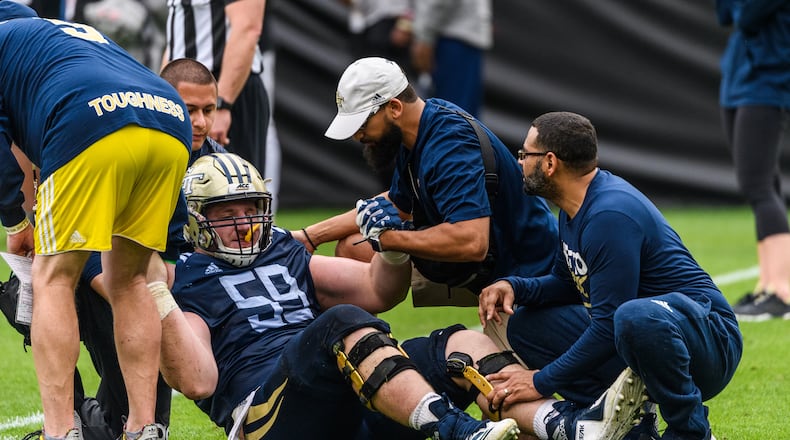Eric Avila, a Georgia Tech athletic trainer since 2018, misses his workplace. He misses the face-to-face interaction with his co-workers on Tech’s sports-medicine staff and being up close with Yellow Jackets football players whose injury rehab he oversees.
Sports medicine is a hands-on job, sometimes literally, hence his restlessness with the impact that social distancing has placed upon his work.
“It’s a little bit different looking at a computer screen,” said Avila in an interview conducted, naturally, via video conference. “If I wanted to look at a computer screen, I would have become an accountant.”
Since college campuses – including Tech’s – closed in March to curtail the spread of the coronavirus pandemic, the task of keeping Jackets athletes healthy or helping them back on their path toward full health has transformed into one far more reliant upon laptops and other digital devices. Avila and his colleagues shared the challenge of this new work environment in a recent interview with the AJC.
“I think the biggest (challenge) is the unknown of everything,” said Mark Smith, who became Tech’s head football trainer in 2018 after the retirement of longtime trainer Jay Shoop. “I think something that we pride ourselves on as clinicians and athletic trainers is our ability to be creative.”
Finding solutions
Across all of Tech’s 17 varsity sports, Tech has about 40 or 50 athletes who are rehabilitating injuries, according to sports-medicine director Carla Gilson. There are many more, though, whom the sports-medicine staff monitors as they heal from smaller aches or pains or get treatment to maintain their health.
Among the solutions is Fusionetics, a sports-medicine platform (the company is based in Milton) through which trainers can assess movement, create a maintenance program and share videos of prescribed exercises for the athletes, among other tools.
Ashley McLendon, who works primarily with the track and field teams, gives her athletes a week’s worth of exercises to perform. For the ones they’re not familiar with, she demonstrates it in a video and includes photos and bullet points. She makes sure to assure that she’s only a phone call away to offer explanations or critiques or show a diagram.
“And then they can even just set up the camera, do the exercise and I’ll watch it right along with them,” she said.
Avila has a similar interaction with a football player.
“I’m doing a rehab now where an athlete’s sending me videos each day, and I correct him,” Avila said. “’Hey, you’re doing this wrong; you’re going too deep on double-leg squats.’”
It is a facsimile, though, of the interaction that would be more efficient if trainers and athletes were in the same place.
“It is hard, but they are doing (the exercises), and it’s great,” Avila said.
‘Do you have a weighted blanket?’
In early March, Smith and Avila were prescient enough to anticipate that the spread of the coronavirus might keep them separated from their rehabbing athletes longer than ideal. So they made packages for football players to take home with items such as resistance bands that they could use while at home for spring break or longer.
For athletes who don’t have such tools, they’re having to adapt.
“It’s like, do you have weights?” McLendon said. “No, you don’t have weights. Do you have a jug of milk? No, you don’t have a jug of milk. Do you have a weighted blanket?”
Implements such as the hot and cold tub, ultrasound machines and compression machines that are integral to rehab and pre- and post-workout routines also have had to be replaced.
In their place are treatments that don’t need to be plugged in – ice baths, elevating your legs, compression stockings, simply contracting and relaxing muscles and taking a longer time to warm up before a workout than usual.
“Those extras are probably what they’re missing the most,” Smith said.
The debate over the therapeutic value of ice, Smith said, “is never-ending, but when you’re stuck in this situation, everybody has access to ice, so if that’s the best thing available, that’s what we’re going to encourage to use.”
As many have discovered, video conferencing has useful applications even at a time when social distancing is the norm. Two football players needed to see a physician, so Avila connected them with a doctor who talked with them via video conference while Avila was looped in as well.
“In the future, if something needs to happen, we can have Zoom, we can have Microsoft Teams, FaceTime, and we can get it done in five minutes or eight minutes,” Avila said.
In a way, this extended stretch without competition or practice isn’t the worst thing for athletes at Tech and beyond, Gilson said.
“A lot of the pounding and the impact that we tend to deal with, we don’t have that as much right now,” said Gilson, who has worked at Tech since 1997 and overseen the sports-medicine staff since 2018. “And that’s a plus.”
Athletes who have reached the Division I level have typically been training year-round with little time for recovery, which can lead to overuse injuries and burnout. While being isolated at home and not competing is no one’s preference, it may have created an unintended benefit.
“There’s a period of recovery that we don’t always tend to get within our seasons,” Gilson said.
As the quarantine continues, Avila said, football players have been communicating their boredom with the prescribed exercises. As the athletes’ whose health he is charged with maintaining often face, Avila is being called to raise his game.
“Then we just kind of mix it up and ‘Do this more’ or ‘You can sprint more’ or things like that,” he said. “It’s just getting creative.”
About the Author
Keep Reading
The Latest
Featured



